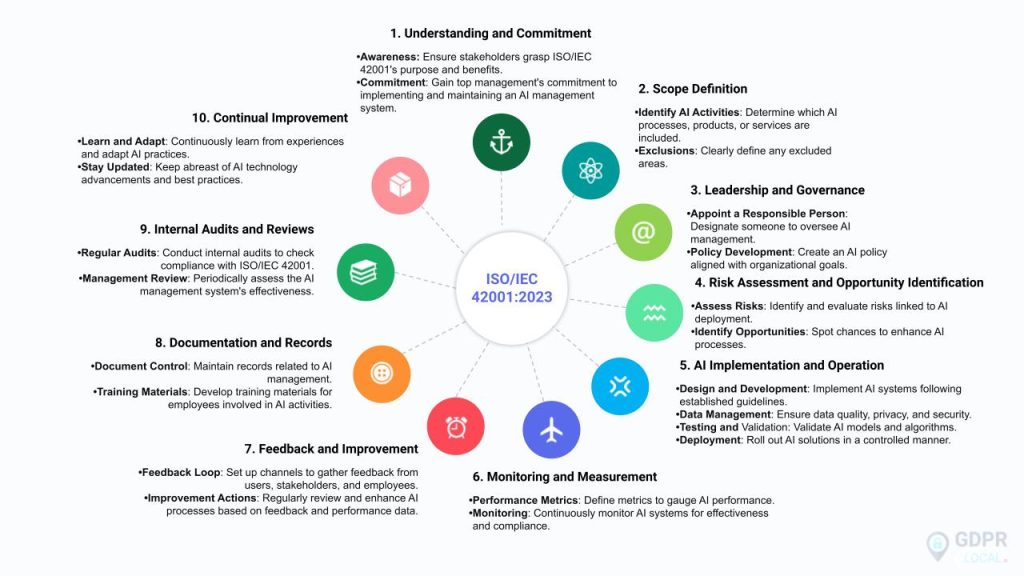
Empower Your AI Strategy: A Guide to ISO/IEC 42001 Implementation
In our recent blogs “The EU’s Artificial Intelligence Act and Its Implications for Business” and “Essential Guide for the New EU AI Act: Navigating through the AI Act” we delved into the transformative impact of the EU’s regulatory measures on companies, shedding light on significant milestones, regulatory requirements, and pertinent considerations. These blogs underscored the Act’s role in overseeing AI systems based on their associated risks, prohibiting certain applications deemed detrimental to rights and democratic principles, while imposing obligations on high-risk systems and general AI.
In this article, we shift our focus to the ISO/IEC 42001:2023 Information technology — Artificial intelligence — Management system, elucidating its relevance in implementing AI management systems within organizational contexts.
ISO/IEC 42001 Unveiled: A Blueprint for AI Management
AI has emerged as a game-changing force, revolutionizing the way we live and work. As we continue to witness the rapid growth and integration of AI in various industries, it has become crucial for organizations to adopt a structured approach towards managing this powerful tool.
This is where ISO/IEC 42001 may come in, providing a comprehensive framework for the implementation and management of AI systems.
What is ISO/IEC 42001 for?
ISO/IEC 42001 stands as a guiding light in the ever-evolving realm of AI offering organizations a robust framework to navigate the complexities and challenges associated with its implementation.
This international standard outlines requirements for establishing, implementing, maintaining, and continually improving AI management systems within organizations, catering to entities involved in providing or utilizing AI-based products or services.
Designed to address the multifaceted nature of AI technology, ISO/IEC 42001 serves as a comprehensive guide for organizations of all sizes and across diverse industries. By providing a structured framework for AI management, it enables entities to effectively manage risks and capitalize on opportunities associated with AI deployment, all while striking a delicate balance between innovation and governance.
Structured Approach: Implementing ISO/IEC 42001 in Your Organization
ISO/IEC 42001 provides a structured framework for managing Artificial Intelligence Management Systems (AIMS) within organizations. It serves as a blueprint to guide responsible development and use of AI, addressing aspects like ethics, transparency, and continuous learning.
Now, let’s explore some examples of AI-based products and services:
Virtual Assistants
These include chatbots, voice assistants (like Siri or Google Assistant), and customer service bots that utilize natural language processing (NLP) to interact with users.
Recommendation Systems
AI algorithms analyze user preferences and behavior, offering personalized suggestions. For instance, Netflix suggests movies, and Amazon recommends products.
Image Recognition
AI-powered systems identify objects, people, or scenes in images. Applications range from facial recognition to security surveillance and medical imaging.
Autonomous Vehicles
Self-driving cars and drones rely on AI for navigation, obstacle detection, and decision-making.
Healthcare Diagnostics
AI assists in medical diagnosis by analyzing images (such as X-rays or MRIs) and predicting diseases.
Natural Language Processing (NLP)
AI models process and understand human language. Examples include language translation, sentiment analysis, and text summarization.
Fraud Detection
AI algorithms detect anomalies in financial transactions, preventing fraud.
Predictive Analytics
AI predicts future outcomes based on historical data, benefiting fields like finance, marketing, and supply chain management.
Gaming
AI opponents in video games adapt strategies based on player behavior.
Smart Home Devices
Devices like smart thermostats, lights, and security cameras use AI for automation and optimization.
All these examples fall into different risk categories as defined by the EU AI Act.
Here is a simplified version of implementation steps for this standard for companies that are developing or deploying some AI-based products and services like mentioned above:

Fostering Responsible AI: Ethical Considerations and Transparency
At its essence, ISO/IEC 42001 fosters responsible AI practices by emphasizing ethical considerations and transparency. For instance, it mandates the implementation of safeguards for various AI features, such as:
– autonomous decision-making,
– ensuring accountability and
– oversight beyond conventional IT systems.
Moreover, by promoting continuous learning and adaptation in AI systems, ISO/IEC 42001 encourages the responsible use of AI technologies over time.
Maximizing Benefits: Leveraging ISO/IEC 42001 for Innovation and Compliance
Implementing ISO/IEC 42001 offers benefits for organizations venturing into the AI landscape. Here are few examples:
Responsible AI Practices
By adhering to ISO/IEC 42001, organizations can establish guidelines and principles for the ethical use of AI, addressing societal impacts and aligning with ethical standards and values. For instance, implementing transparency requirements for AI systems like chatbots ensures accountability and fosters trust among stakeholders.
Enhanced Reputation
ISO/IEC 42001 helps organizations build and maintain a positive reputation by demonstrating their commitment to ethical AI practices. Adhering to the standard showcases an organization’s dedication to responsible AI deployment, thus enhancing its credibility and trustworthiness in the eyes of stakeholders and the public.
Compliance with Legal and Regulatory Standards
ISO/IEC 42001 provides a structured framework that aligns AI practices with relevant regulations, helping organizations steer clear of legal pitfalls. For example, implementing mandatory human rights impact assessments for high-risk AI deployments ensures compliance with regulatory requirements and mitigates legal risks.
Effective Risk Management
ISO/IEC 42001 offers practical guidance on managing AI-specific risks, enabling organizations to identify, assess, and mitigate potential risks associated with AI implementation. For instance, addressing risks related to data privacy and security ensures the robustness and reliability of AI systems, thereby safeguarding against potential vulnerabilities.
Promoting Innovation
While ensuring responsible AI practices, ISO/IEC 42001 also encourages innovation within defined parameters. By providing a structured framework for innovation, organizations can explore and integrate AI technologies in ways that foster creativity and advancement. For example, establishing AI regulatory sandboxes promotes real-world testing and innovation in a controlled environment, fostering the development of cutting-edge AI solutions.
In summary, ISO/IEC 42001 not only champions responsible and ethical AI practices but also provides a comprehensive framework for organizations to manage risks, comply with regulations, and instill trust in their AI applications. By aligning AI management with established best practices, ISO/IEC 42001 paves the way for sustainable growth and success in the rapidly evolving landscape of AI technology.